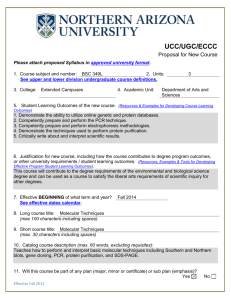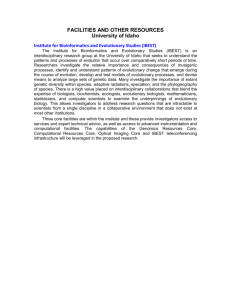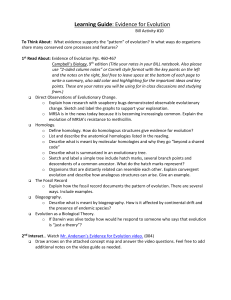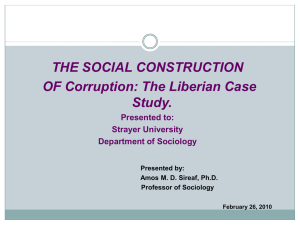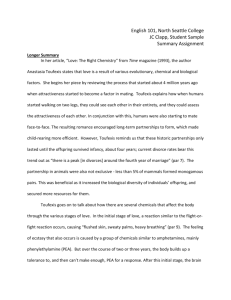BSC 435C - New Course - nau.edu
advertisement
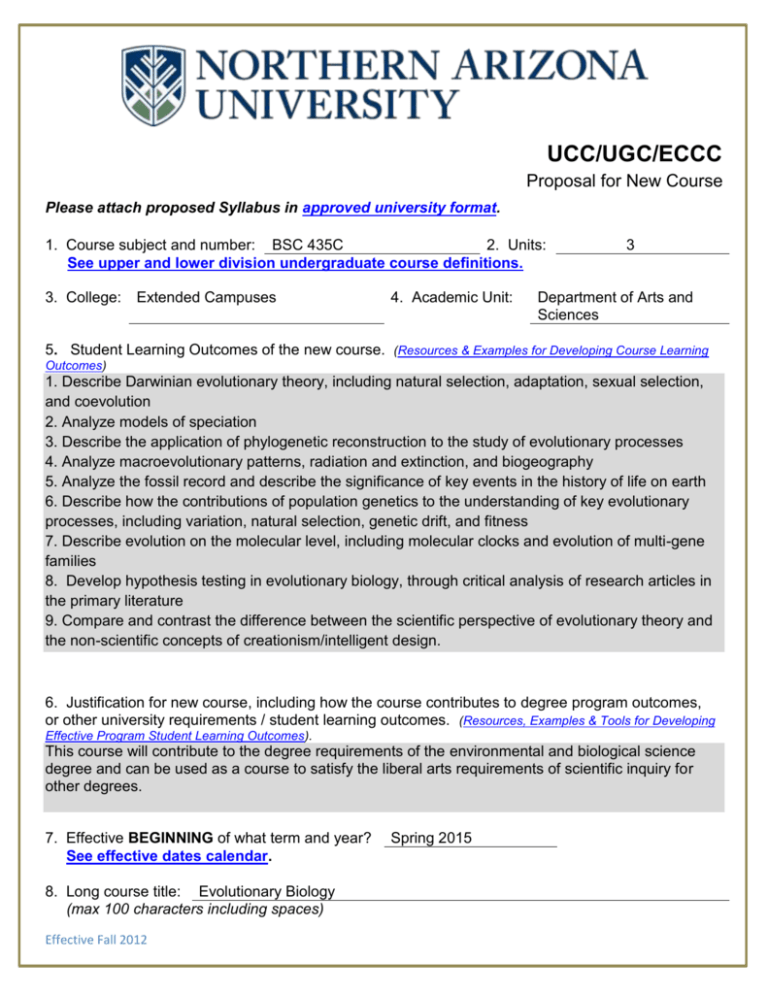
UCC/UGC/ECCC Proposal for New Course Please attach proposed Syllabus in approved university format. 1. Course subject and number: BSC 435C 2. Units: See upper and lower division undergraduate course definitions. 3. College: Extended Campuses 4. Academic Unit: 3 Department of Arts and Sciences 5. Student Learning Outcomes of the new course. (Resources & Examples for Developing Course Learning Outcomes) 1. Describe Darwinian evolutionary theory, including natural selection, adaptation, sexual selection, and coevolution 2. Analyze models of speciation 3. Describe the application of phylogenetic reconstruction to the study of evolutionary processes 4. Analyze macroevolutionary patterns, radiation and extinction, and biogeography 5. Analyze the fossil record and describe the significance of key events in the history of life on earth 6. Describe how the contributions of population genetics to the understanding of key evolutionary processes, including variation, natural selection, genetic drift, and fitness 7. Describe evolution on the molecular level, including molecular clocks and evolution of multi-gene families 8. Develop hypothesis testing in evolutionary biology, through critical analysis of research articles in the primary literature 9. Compare and contrast the difference between the scientific perspective of evolutionary theory and the non-scientific concepts of creationism/intelligent design. 6. Justification for new course, including how the course contributes to degree program outcomes, or other university requirements / student learning outcomes. (Resources, Examples & Tools for Developing Effective Program Student Learning Outcomes). This course will contribute to the degree requirements of the environmental and biological science degree and can be used as a course to satisfy the liberal arts requirements of scientific inquiry for other degrees. 7. Effective BEGINNING of what term and year? See effective dates calendar. 8. Long course title: Evolutionary Biology (max 100 characters including spaces) Effective Fall 2012 Spring 2015 9. Short course title: Evolutionary Biology (max. 30 characters including spaces) 10. Catalog course description (max. 60 words, excluding requisites): Evolution of organisms: including variation, natural selection, adaptation, population genetics, speciation, patterns and rates of evolution, phylogenetics, and the fossil record. CAP 11. Will this course be part of any plan (major, minor or certificate) or sub plan (emphasis)? Yes If yes, include the appropriate plan proposal. No 12. Does this course duplicate content of existing courses? Yes No If yes, list the courses with duplicate material. If the duplication is greater than 20%, explain why NAU should establish this course. BIO 435C, BSC courses were created to meet the needs, requirements, and degree requirements associated with the biological science degree that builds on the partnership with community colleges in the Lower Colorado River region. 13. Will this course impact any other academic unit’s enrollment or plan(s)? Yes No If yes, describe the impact. If applicable, include evidence of notification to and/or response from each impacted academic unit 14. Grading option: Letter grade Pass/Fail Both 15. Co-convened with: N/A 14a. UGC approval date*: (For example: ESE 450 and ESE 550) See co-convening policy. *Must be approved by UGC before UCC submission, and both course syllabi must be presented. 16. Cross-listed with: N/A (For example: ES 450 and DIS 450) See cross listing policy. Please submit a single cross-listed syllabus that will be used for all cross-listed courses. 17. May course be repeated for additional units? 16a. If yes, maximum units allowed? 16b. If yes, may course be repeated for additional units in the same term? Yes No Yes No 18. Prerequisites: BSC 350 If prerequisites, include the rationale for the prerequisites. BIO 350 introduces students to some of the main principles that are paramount to this course. Successfully passing BSC 350 will adequately prepare students to succeed in this course. Effective Fall 2012 19. Co requisites: None If co requisites, include the rationale for the co requisites. 20. Does this course include combined lecture and lab components? Yes If yes, include the units specific to each component in the course description above. 21. Names of the current faculty qualified to teach this course: No Dr. Marie McGee Answer 22-23 for UCC/ECCC only: 22. Is this course being proposed for Liberal Studies designation? If yes, include a Liberal Studies proposal and syllabus with this proposal. Yes 23. Is this course being proposed for Diversity designation? If yes, include a Diversity proposal and syllabus with this proposal. Yes FLAGSTAFF MOUNTAIN CAMPUS Reviewed by Curriculum Process Associate Date Approvals: Department Chair/Unit Head (if appropriate) Date Chair of college curriculum committee Date Dean of college Date For Committee use only: UCC/UGC Approval Approved as submitted: Effective Fall 2012 Date Yes No No No Approved as modified: Yes No EXTENDED CAMPUSES Jenny Scott 10.16.13 Reviewed by Curriculum Process Associate Date Approvals: Academic Unit Head Date Division Curriculum Committee (Yuma, Yavapai, or Personalized Learning) Date Division Administrator in Extended Campuses (Yuma, Yavapai, or Personalized Learning) Date Faculty Chair of Extended Campuses Curriculum Committee (Yuma, Yavapai, or Personalized Learning) Date Chief Academic Officer; Extended Campuses (or Designee) Date Approved as submitted: Yes No Approved as modified: Yes No Effective Fall 2012 COURSE SYLLABUS – APPROVED FORMAT General Information Northern Arizona University- Yuma; Department of Arts and Sciences BSC 435C, Evolutionary Biology Spring 3 hrs. Lecture, 3 credit hours Marie McGee Science and Research building, Office 112 Office hours: Monday/Wednesday 8:00am to 9:00am and 4:00pm to 5:00pm Course prerequisites BSC 350 Course Corequisite None Course description: Evolution of organisms, including variation, natural selection, adaptation, population genetics, speciation, patterns and rates of evolution, phylogenetics, and the fossil record. Letter grade only. CAP Student Learning Expectations/Outcomes for this Course Upon satisfactory completion of this course, the student will be able to: 1. Describe Darwinian evolutionary theory, including natural selection, adaptation, sexual selection, and coevolution 2. Analyze models of speciation 3. Describe the application of phylogenetic reconstruction to the study of evolutionary processes 4. Analyze macroevolutionary patterns, radiation and extinction, and biogeography 5. Analyze the fossil record and describe the significance of key events in the history of life on earth 6. Describe how the contributions of population genetics to the understanding of key evolutionary processes, including variation, natural selection, genetic drift, and fitness 7. Describe evolution on the molecular level, including molecular clocks and evolution of multi-gene families 8. Develop hypothesis testing in evolutionary biology, through critical analysis of research articles in the primary literature 9. Compare and contrast the difference between the scientific perspective of evolutionary theory and the nonscientific concepts of creationism/intelligent design. Effective Fall 2012 Course structure/approach: The course may involve one or more of the following approaches: lecture and discussion; application exercises; scheduled activities; case analysis; team projects; field trips, speakers with relevant expertise, and/or other activities as appropriate to achieve learning outcomes. Textbook and required materials: Student learning is facilitated with textbooks, readings, audio-visual content, software, and/or other materials Recommended optional materials/references (attach reading list): None Course outline: Week 1: Evolutionary Science, creationism and society Week 2: Nova film: Intelligent Design on Trial Week 3: Evolutionary Biology Week 4: Tree of Life: Classification and Phylogeny Week 5: Patterns of Evolution Week 6: Cladistics and interpreting phylogenetic trees Week 7: Evolution in the Fossil Record Week 8: History of Life on Earth Week 9: Sex and Reproductive Success Week 10: The Geography of Evolution: Biogeography Week 11: The Evolution of Biodiversity Week 12: The Origin of Genetic Variation Week 13: Conflict and Cooperation Week 14: Genetic Drift: Evolution at Random Week 15: Natural Selection and Adaptation Week 16: The Genetical Theory of Natural Selection Assessment of Student Learning Outcomes Methods of Assessment: In-class exams, homework, in-class activities, research paper, and/or presentations. Timeline for Assessment: Over the course of the semester Grading System: Letter grades for the course will be determined based on the percentage of the total points as follows: 90-100% A Excellent 80-89% B Good 70-79% C Average 60-69% D Lowest passing <60% F Failure Course policy: Retests/makeup tests: No make-up exams or re-tests except for what the instructor may deem as extenuating circumstances. Attendance Policy: Under NAU Policy, students are expected to attend every session of the class in which they are enrolled. Effective Fall 2012 Statement on plagiarism and cheating: DON’T CHEAT! Please refer to the NAU Student Handbook policy statement on Academic Integrity. Academic honesty does not allow "plagiarism — knowingly representing the words or ideas of another as one's own" (2005, Undergraduate General Academic and Graduation Policies). If your instructor determines that you are guilty of plagiarism he deserves the right to give you a zero on the alleged assignment up to failing the course in question. All incidents regardless will be reported to the university. University policies Attach the Safe Working and Learning Environment, Students with Disabilities, Institutional Review Board, and Academic Integrity policies or reference them on the syllabus. See the following document for policy statements: http://www4.nau.edu/avpaa/UCCPolicy/plcystmt.html. Your instructor reserves the right to make any changes to the course policies, schedule, or any other aspect of the class as he sees fit. Effective Fall 2012
